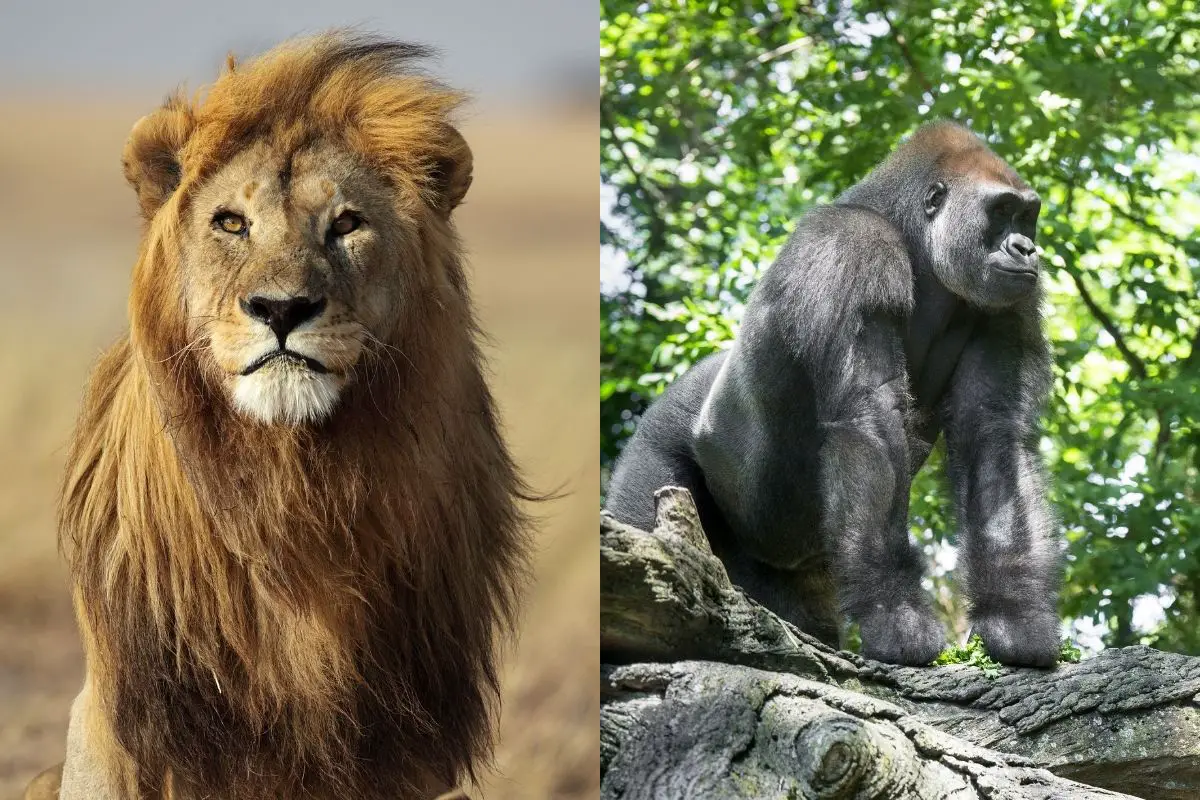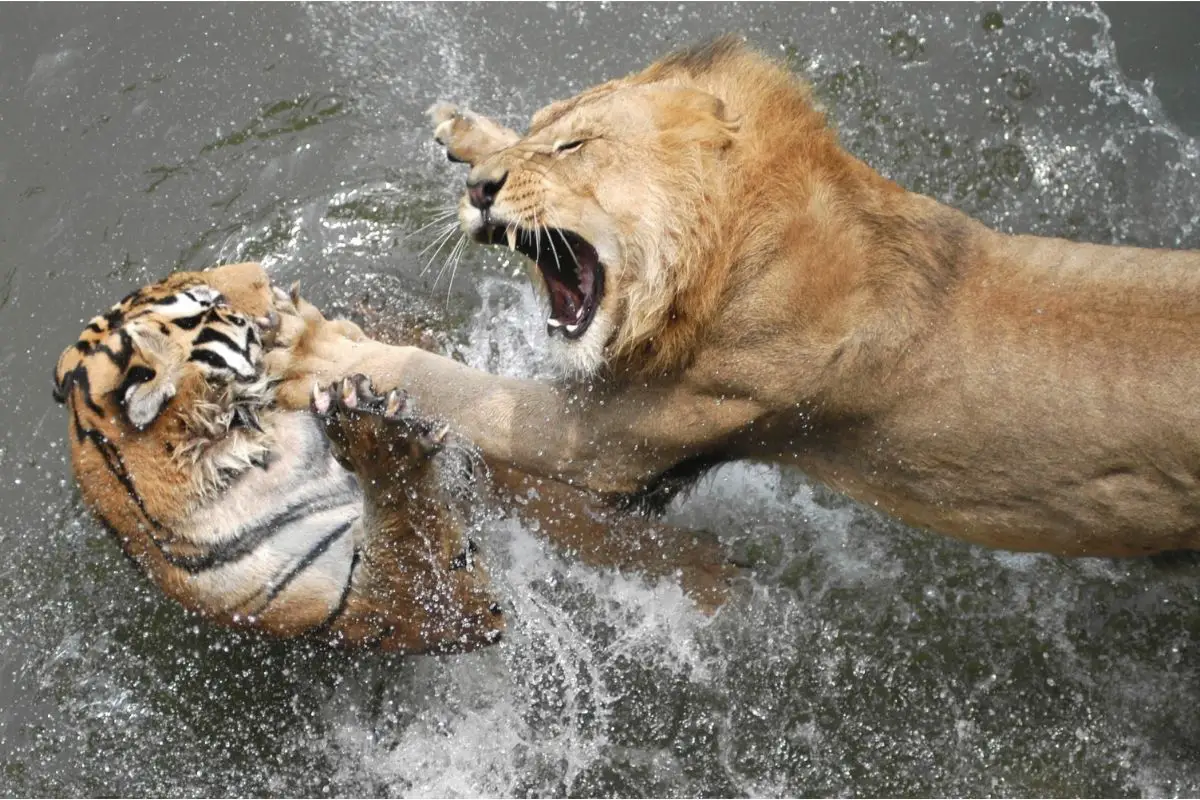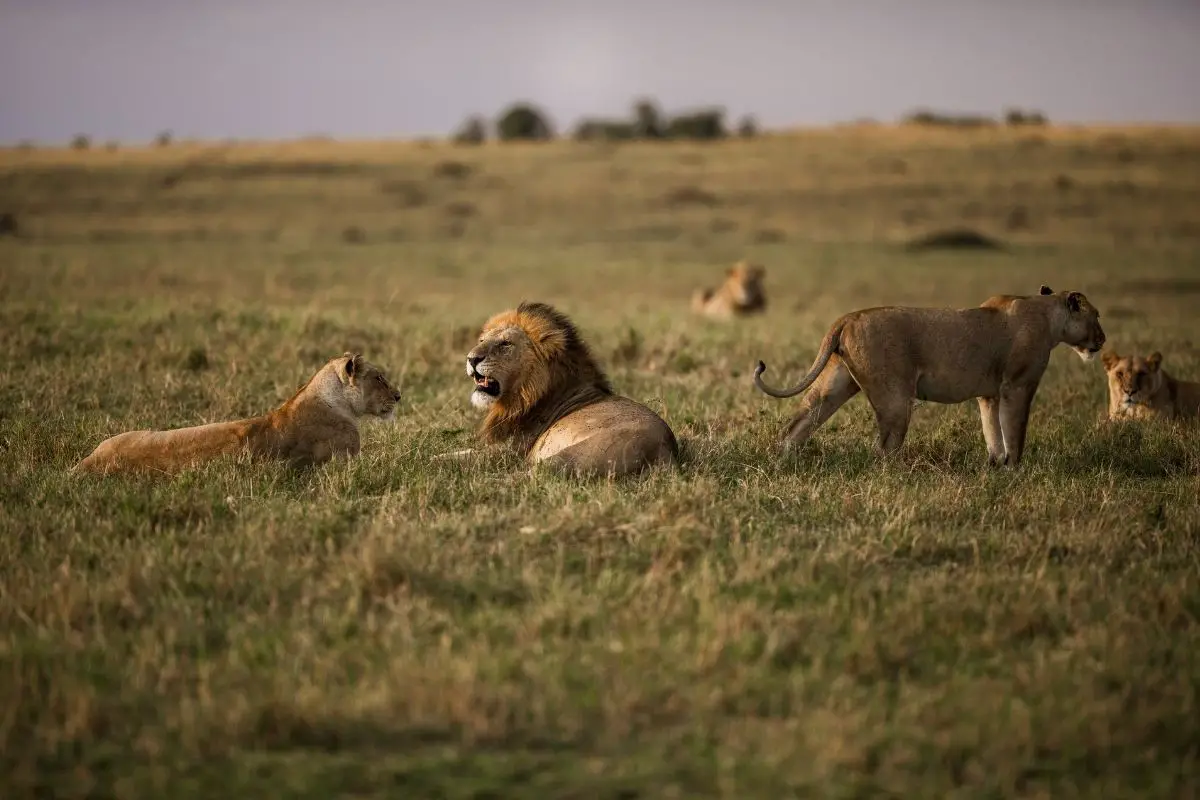Updated: July 2025
In the ultimate wildlife showdown, who would emerge victorious in a battle between a bear and a lion? This fascinating question has captivated animal enthusiasts for generations, and the answer might surprise you.
Both animals are apex predators with distinct advantages. Lions are skilled hunters that rely on teamwork and precision strikes, while bears are massive powerhouses with incredible individual strength. But when these titans clash, which attributes matter most?
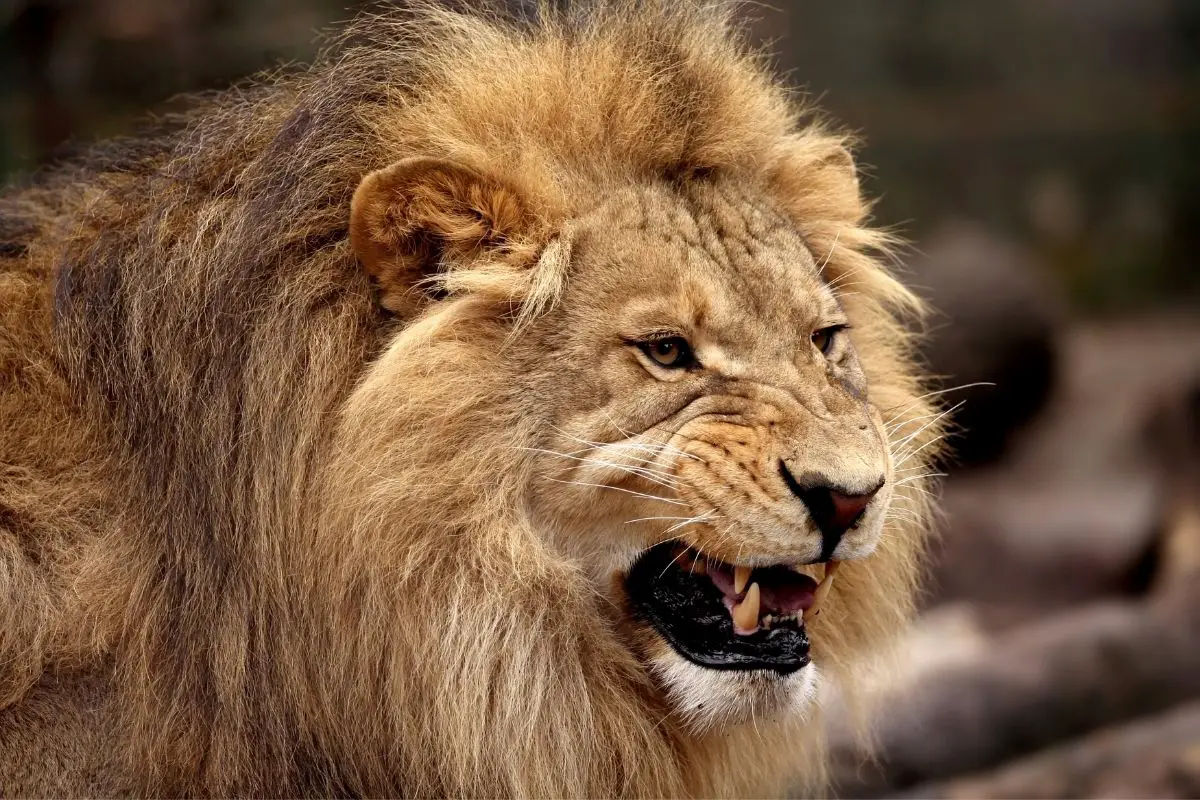
The dietary differences between these animals reveal much about their fighting capabilities. Bears are omnivores with a diet consisting of roughly 60% vegetation and 40% meat, including fish, small mammals, and carrion. This varied diet contributes to their massive size and strength.
Lions, as obligate carnivores, consume only meat and have evolved as specialized killing machines. Their entire anatomy is designed for hunting and combat, but does this specialization give them an edge against a bear’s brute force?
Size plays a crucial role in this matchup. The largest bear species significantly outweigh even the biggest lions, with some grizzly bears reaching up to 1,700 pounds during peak season, while the largest male lions typically max out around 570 pounds.
This comprehensive analysis examines every aspect of this hypothetical battle, from physical attributes to fighting techniques, helping you understand which animal would likely emerge victorious in this epic confrontation.
The Bear: Nature’s Heavyweight Champion
Bears are among the most powerful land mammals on Earth. These omnivorous giants possess 4-inch claws that serve multiple purposes: digging for roots, catching fish, and defending against threats. Their thick fur provides insulation and some protection against attacks.
There are eight species of bears worldwide, with the Kodiak bear and polar bear being the largest. Grizzly bears, perhaps the most famous fighters, are incredibly versatile predators found across North America, Europe, and Asia.
Grizzly bears have a distinctive humped shoulder muscle that provides enormous power for digging and striking. Their paws are partially webbed for swimming, and they can run up to 35 mph despite their massive size. Adult males can weigh 400-1,700 pounds depending on the season and food availability.
Bears are typically solitary animals, coming together only during mating season. Females are especially fierce when protecting cubs, displaying incredible aggression and fearlessness against much larger threats.
Most bear species hibernate during winter, entering a state called torpor where their metabolism slows dramatically. They emerge in spring with reduced body weight but retain their muscle mass and fighting ability.
During late summer, bears enter hyperphagia, consuming up to 20,000 calories daily to build fat reserves. This seasonal behavior makes them particularly large and powerful during certain times of year.
Bears are intelligent animals with excellent problem-solving abilities. They can stand on their hind legs to appear more intimidating, reaching heights of 10 feet or more in some species.
The Lion: Africa’s Apex Predator
Lions are the ultimate cooperative hunters, evolved for speed, agility, and precision killing. They can reach speeds of 50 mph in short bursts and are capable of taking down prey much larger than themselves through coordinated attacks.
There are two main subspecies of lions today: African lions and the critically endangered Asiatic lions. African lions are larger, with males weighing 330-570 pounds and females averaging 265-395 pounds.
As members of the Felidae family, lions possess retractable claws that stay sharp through minimal ground contact. These claws, combined with powerful leg muscles, allow them to grip and control prey effectively.
Male lions sport impressive manes that serve multiple purposes: protection during fights, intimidation displays, and attracting females. Darker, fuller manes typically indicate higher testosterone levels and better fighting ability.
Lions have excellent night vision, being most active during dawn and dusk. Their eyes are six times more sensitive to light than human eyes, giving them a significant advantage in low-light conditions.
Their jaw structure is optimized for delivering fatal bites. Lions typically kill by suffocation, clamping down on the throat or muzzle of their prey and maintaining pressure until the animal expires.
Bear VS Lion: The Ultimate Comparison
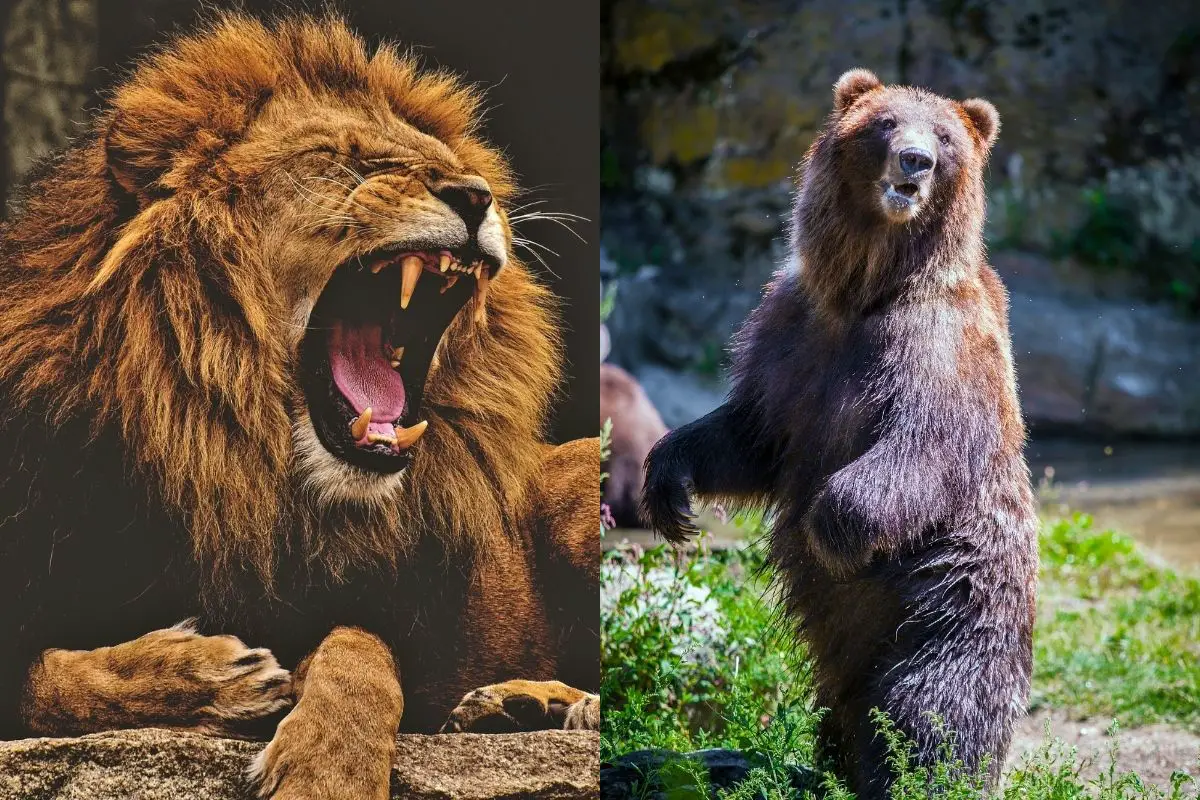
Size and Weight Advantage
The size difference is overwhelming in favor of bears. A large grizzly bear can weigh three times more than the biggest lion. This massive weight advantage translates directly into striking power and ability to absorb damage.
When bears rear up on their hind legs during confrontations, they can reach 9-10 feet in height, creating an incredibly intimidating presence. This position also allows them to deliver devastating downward strikes with their front paws.
Even the largest recorded lion (827 pounds) would be significantly outweighed by an average adult male grizzly bear during peak season. This size disparity creates a fundamental advantage for the bear in any physical confrontation.
Speed and Agility
Lions have a clear advantage in speed and agility. They can maintain 50 mph for longer distances and change direction rapidly during pursuit. Their flexible spine and powerful leg muscles allow for incredible acceleration and maneuverability.
Bears can reach similar top speeds (35 mph) but cannot maintain high speeds as long as lions. However, bears are surprisingly agile for their size and can climb trees, swim effectively, and navigate difficult terrain.
In a fight scenario, the lion’s speed advantage would be most valuable for hit-and-run tactics or attempting to avoid the bear’s powerful strikes while looking for an opening.
Raw Strength Comparison
Bears possess extraordinary physical strength that far exceeds that of lions. A grizzly bear can flip over 700-pound rocks with ease and has been observed moving logs weighing over 1,000 pounds.
The bear’s shoulder hump contains massive muscle groups that power their front legs. A single swipe from a bear’s paw can generate enough force to break the spine of large animals, with some estimates suggesting 25,000 pounds of force per square inch.
While lions are incredibly strong for their size, particularly in their forelegs and jaw muscles, they cannot match the sheer brute force that bears can generate. Bears are estimated to be 2.5 times stronger than lions pound-for-pound.
Bite Force and Dental Weapons
Bears deliver more powerful bites, with grizzly bears generating 1,200 PSI of bite force. Their teeth are designed for crushing bones and tearing through tough materials, with canines reaching 2-3 inches in length.
Lions have a weaker bite force at 650 PSI, but their 4-inch canine teeth are perfectly designed for precision killing. Lions’ teeth are sharper and more effective at penetrating vital areas quickly.
While the bear has the more powerful bite, the lion’s dental structure is more specialized for delivering fatal wounds. However, the bear’s bite force advantage combined with their massive skull structure gives them the edge in this category.
Sensory Capabilities
Bears have an exceptional sense of smell, reportedly 2,100 times better than humans. They can detect food sources from miles away and use scent to avoid dangerous confrontations or track potential threats.
Their hearing is also twice as acute as humans, and while their eyesight is moderate, it improves significantly in low-light conditions. Bears can detect movement and threats from considerable distances.
Lions excel in visual hunting, with superior night vision and excellent depth perception. They can spot prey from up to 2 miles away and have keen hearing that helps them coordinate group hunts. Lions have a slight edge in overall sensory capabilities due to their specialized hunting adaptations.
Combat Techniques and Weapons
Bears employ devastating paw strikes as their primary weapon, capable of delivering bone-crushing blows with their massive front legs. They also use their powerful bite to grab and shake opponents, similar to how they handle large fish.
Lions use coordinated attack strategies involving their claws to grip and control prey while delivering precise bite wounds to vital areas. They’re experts at grappling and wrestling opponents to the ground.
Bears have 4-inch claws that don’t retract, remaining constantly sharp from digging and climbing. Lions have retractable claws that stay razor-sharp but are shorter at around 1.5 inches.
Bears have superior offensive capabilities due to their size, strength, and ability to deliver multiple types of attacks simultaneously. A bear can strike with both paws while biting, creating overwhelming offensive pressure.
The Verdict: Who Would Win?
The bear would win this fight in most scenarios. The combination of superior size, strength, and offensive capabilities creates an insurmountable advantage over the lion’s speed and agility benefits.
While a lion might win through perfect ambush tactics – delivering a precise killing bite before the bear can react – this scenario is unlikely given bears’ excellent senses and thick neck protection.
The bear’s massive size advantage (potentially 3x the lion’s weight) combined with superior bite force and devastating paw strikes would overwhelm even the most skilled lion. The bear’s thick hide and fat layer also provide significant protection against the lion’s claws and teeth.
Historical accounts from circuses and documented encounters in the wild support this conclusion. Bears consistently dominate in confrontations with large cats, using their size and strength to end fights quickly.
Final Thoughts
This analysis of a bear vs lion fight reveals that while both animals are formidable predators, the bear’s physical advantages are simply too significant to overcome.
The bear wins approximately 8 out of 10 encounters based on size, strength, and combat capabilities. While lions are incredible hunters and fighters, they’re evolved for different types of combat against different opponents.
Remember, both species are magnificent apex predators that deserve our respect and protection. These hypothetical battles help us appreciate the incredible diversity and power of nature’s most impressive predators.
- Bengal Cat vs Wild Bengal Tiger: Complete Comparison 2025 - October 31, 2025
- Complete Wild Cat Spotting Guide for Hikers 2025 - October 31, 2025
- Lynx vs Bobcat: Complete Field Identification Guide 2025 - October 30, 2025

